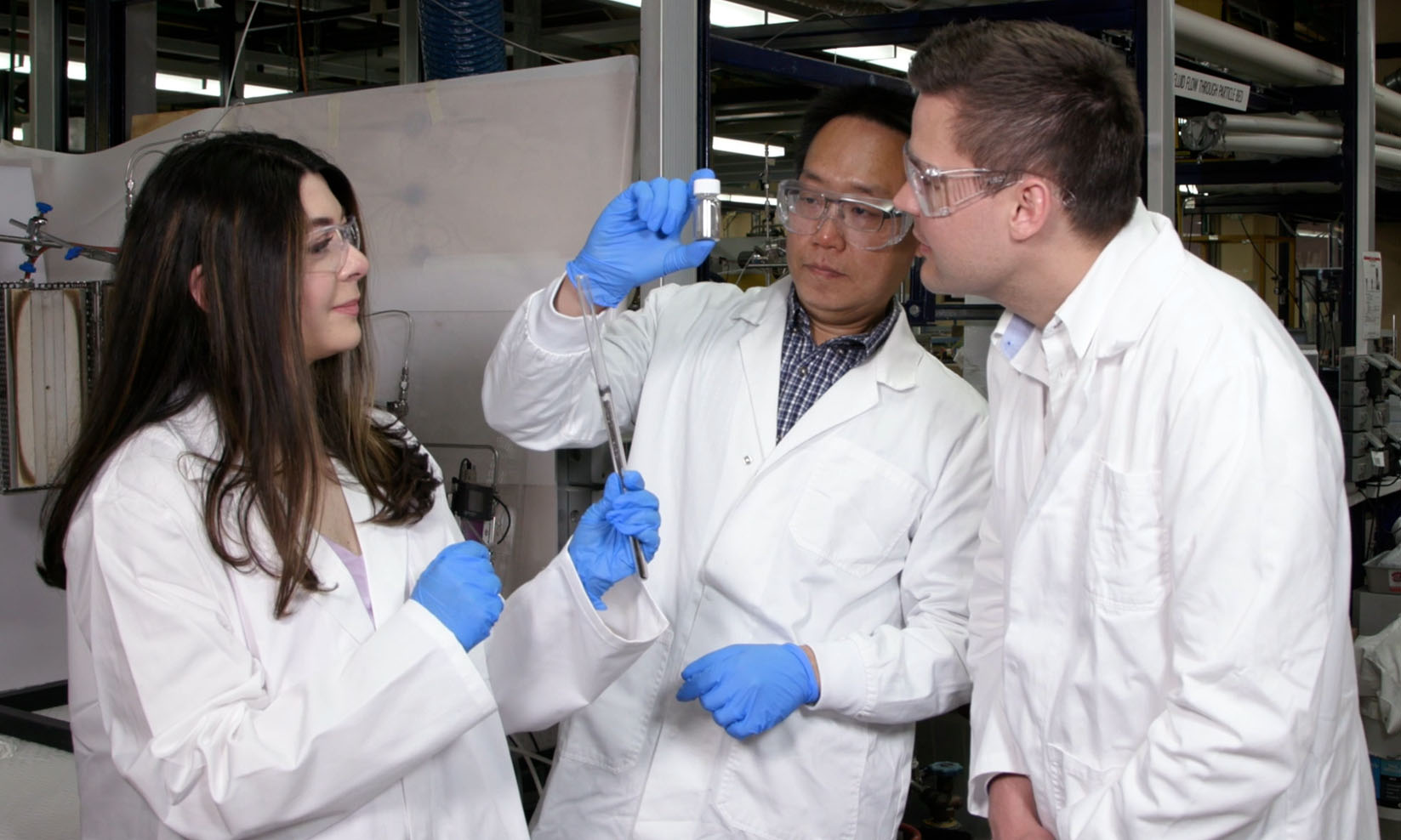
Decarbonisation tech instantly converts CO2 to solid carbon
Researchers have developed a smart and super-efficient new way of capturing carbon dioxide and converting it to solid carbon, to help advance the decarbonisation of heavy industries.
The carbon dioxide utilisation technology from RMIT researchers is designed to be smoothly integrated into existing industrial processes.
Decarbonisation is an immense technical challenge for heavy industries like cement and steel, which are not only energy-intensive but also directly emit CO2 as part of the production process.
The new technology offers a pathway for instantly converting carbon dioxide as it is produced and locking it permanently in a solid state, keeping CO2 out of the atmosphere.
The research is published in the journal Energy & Environmental Science.
Co-lead researcher Associate Professor Torben Daeneke said the work built on an earlier experimental approach that used liquid metals as a catalyst.
“Our new method still harnesses the power of liquid metals but the design has been modified for smoother integration into standard industrial processes,” Daeneke said.
“As well as being simpler to scale up, the new tech is radically more efficient and can break down CO2 to carbon in an instant.
“We hope this could be a significant new tool in the push towards decarbonisation, to help industries and governments deliver on their climate commitments and bring us radically closer to net zero.”
A provisional patent application has been filed for the technology and researchers have recently signed a $AUD2.6 million agreement with Australian environmental technology company ABR, who are commercialising technologies to decarbonise the cement and steel manufacturing industries.
 Liquid metal is at the heart of the new carbon dioxide utilisation technology.
Liquid metal is at the heart of the new carbon dioxide utilisation technology.
Co-lead researcher Dr Ken Chiang said the team was keen to hear from other companies to understand the challenges in difficult-to-decarbonise industries and identify other potential applications of the technology.
“To accelerate the sustainable industrial revolution and the zero carbon economy, we need smart technical solutions and effective research-industry collaborations,” Chiang said.
The steel and cement industries are each responsible for about 7% of total global CO2 emissions (International Energy Agency), with both sectors expected to continue growing over coming decades as demand is fuelled by population growth and urbanisation.
Technologies for carbon capture and storage (CCS) have largely focused on compressing the gas into a liquid and injecting it underground, but this comes with significant engineering challenges and environmental concerns. CCS has also drawn criticism for being too expensive and energy-intensive for widespread use.
Daeneke, an Australian Research Council DECRA Fellow, said the new approach offered a sustainable alternative, with the aim of both preventing CO2 emissions and delivering value-added reutilisation of carbon.
“Turning CO2 into a solid avoids potential issues of leakage and locks it away securely and indefinitely,” he said.
“And because our process does not use very high temperatures, it would be feasible to power the reaction with renewable energy.”
The Australian Government has highlighted CCS as a priority technology for investment in its net zero plan, announcing a $1 billion fund for the development of new low emissions technologies.
How the tech works
The RMIT team, with lead author and PhD researcher Karma Zuraiqi, employed thermal chemistry methods widely used by industry in their development of the new CCS tech.
The “bubble column” method starts with liquid metal being heated to about 100-120°C.
Carbon dioxide is injected into the liquid metal, with the gas bubbles rising up just like bubbles in a champagne glass.
As the bubbles move through the liquid metal, the gas molecule splits up to form flakes of solid carbon, with the reaction taking just a split second.
“It’s the extraordinary speed of the chemical reaction we have achieved that makes our technology commercially viable, where so many alternative approaches have struggled,” Chiang said.
 PhD researcher Karma Zuraiqi with Dr Ken Chiang and Associate Professor Torben Daeneke.
PhD researcher Karma Zuraiqi with Dr Ken Chiang and Associate Professor Torben Daeneke.
The next stage in the research is scaling up the proof-of-concept to a modularized prototype the size of a shipping container, in collaboration with industry partner ABR.
ABR Project Director David Ngo said the RMIT process turns a waste product into a core ingredient in the next generation of cement blends.
“Climate change will not be solved by one single solution, however, the collaboration between ABR and RMIT will yield an efficient and effective technology for our net-zero goals,” Ngo said.
The team is also investigating potential applications for the converted carbon, including in construction materials.
“Ideally the carbon we make could be turned into a value-added product, contributing to the circular economy and enabling the CCS technology to pay for itself over time,” Daeneke said.
The research involved a multi-disciplinary collaboration across engineering and science, with RMIT co-authors Jonathan Clarke-Hannaford, Billy James Murdoch, Associate Professor Kalpit Shah and Professor Michelle Spencer.
‘Direct Conversion of CO2 to Solid Carbon by Liquid Metals’, with collaborators from University of Melbourne and Deakin University, is published in Energy & Environmental Science (DOI: 10.1039/d1ee03283f).
Video (original file), B-roll, interview grabs, images: Available for download
Media enquiries: Gosia Kaszubska, +61 417 510 735 or gosia.kaszubska@rmit.edu.au
- Sustainability
- Science and technology
- Research
- Engineering
- Advanced Materials
- Industry
- Environment
Acknowledgement of Country
RMIT University acknowledges the people of the Woi wurrung and Boon wurrung language groups of the eastern Kulin Nation on whose unceded lands we conduct the business of the University. RMIT University respectfully acknowledges their Ancestors and Elders, past and present. RMIT also acknowledges the Traditional Custodians and their Ancestors of the lands and waters across Australia where we conduct our business - Artwork 'Sentient' by Hollie Johnson, Gunaikurnai and Monero Ngarigo.